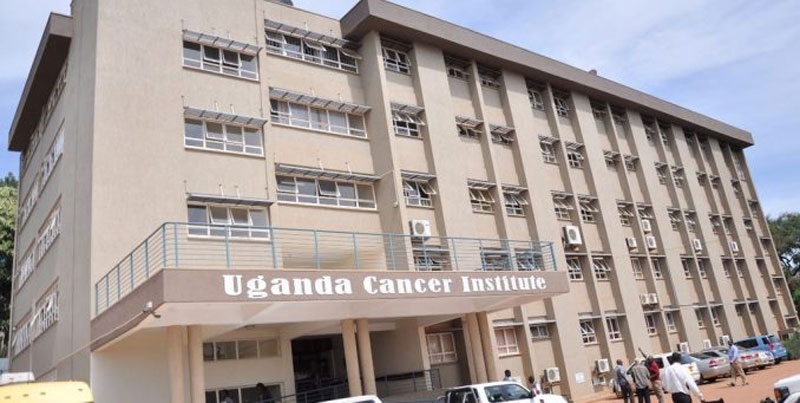Health
Cancer: Ugandans evade free vaccination
Joyce Nabuule, 29, a former teacher at Konge Nursery School in Masaka district, lies in excruciating pain on one of the beds of the Uganda Cancer Institute (UCI) at Mulago.
Nabuule, a mother of two boys, was diagnosed with stage 4 Cancer of the Cervix by doctors at the UCI and was told that her delay to test for the disease allowed the cancer to spread to a point at which they could not treat it.
Currently, Nabuule’s only source of respite is the strongest known painkiller available called Morphine, administered only in major hospitals and mostly to patients with extreme pain or in end-of-life conditions.
By the time our reporter met Nabuule this week, she was yet to receive her injection which is administered once every 24 hours. Sadly for Nabuule, the pain stops for just three hours. It is also the only time, according to her young sister and caretaker, that she sleeps. Nabuule spends the rest of the day crying, gritting her teeth from the unbearable pain.
Her situation is so dire that she can hardly bring together her legs or walk. The foul smell that comes with passing faeces through the cervix illustrates the severity and pain of the disease.
Speaking to this reporter, Nabuule cried out: “I feel a lot of fire and pain every second I spend on earth. The painkillers no longer work. Had I gone for early check-up, I probably would be living a normal life but not this pain! I wish I die, but my two young boys!” She sobbed.
Harriet, 23, Nabuule’s caretaker noted: “My big sister is enduring the pain I have never seen. She only rests after the morphine injection and that is for only 3 hours and she spends all that period sleeping. She hardly eats but just drinks soft drinks. But these too make me to change bed sheets so frequently as her muscles relapsed and she can no longer hold the urine or sometimes the faeces.”
Thousands of women in Uganda endure similar pain from Cancer of the Cervix every year and in majority of the cases, the victims lose the battle to the disease.
According to the Kampala Cancer Registry, Cervical Cancer is the most common type of cancer in Uganda, followed by Prostate Cancer and Breast cancer.
Records from the World Health Organisation (WHO) indicate that in 2014, some 3915 Ugandan women were diagnosed with cervical cancer and only 1755 (45%) survived the disease that year. This low survival rate is attributed to low levels of tests, hence late diagnosis of the disease.
It is stoppable
Despite the evident scale of the problem, there is hope that the disease could become a thing of the past, thanks to the introduction of a vaccine that protects recipients.
Research shows that the vaccine stimulates the body to produce antibodies that, in future encounters with the Human Papilloma Virus (HPV), bind to the virus and prevent it from infecting cells. HPV is the virus which causes Cancer of the Cervix
Vaccination against the HPV was introduced in Uganda in 2015 and is administered to girls aged between nine and 13 free of charge. The vaccine targets HPV type 6, 11, 16 and 18.
Dr. Diana Atwine, the Permanent Secretary, Ministry of Health, said recently that the HPV vaccination was available at hospitals and immunisation centres. Unfortunately, however, reports from the ministry show that parents are not taking up the free government-offered opportunity to vaccinate their children against the virus.
Dr. Bernard Opar Toliva, the Program Manager of the Uganda National Expanded Program on Immunization (UNEPI) says that although 83 percent of young girls received the first dose of the HPV in 2016, only 22 percent went back for the second doze. This means that those that didn’t go for second dose are still susceptible to the disease since one is only considered fully vaccinated if they get the dose in a space of six months.
In 2017, however, the ministry’s target of 85 percent coverage was reached for the first doze but only 41% returned for the second dose. In January 2018, the turn-up was just 27 percent of the targeted pre-and early teenage girls for the first dose and only 15% responded to the 2nd dose.
Dr Opar said: “There is still very low coverage for HPV2 in the country yet Cancer of the Cervix is now ranked as the most common type of cancer among women in Uganda. This calls for more awareness to stop this cancer because it is increasing at a high rate.”
Opar further attributed the lapses to leadership gaps at district level, insufficient knowledge and perceptions about children, and non involvement of other stakeholders in the education sector. He also blamed fear among the elites whose minds, he said, are always linking some programmes to negative forces of politics.
In response to current fears surrounding immunisation since the revelations of fake Hepatitis B vaccines a few weeks ago, Opar re-assure parents and the general public that the HPV is safe, effective, free and that it is approved by the Ministry of Health, the World Health Organization (WHO) and the United Nations International Children’s Education Fund (UNICEF).
Scale of Cervical Cancer
A study conducted in July 2017 by the Human Papilloma Virus (HPV) Information Centre, based in Barcelona, Spain with an office in Uganda, found very low levels of cervical cancer screening among women in rural Uganda.
This is attributed to challenges such as long distances to health facilities and costs of the service, and individual negative perceptions related to having no signs and symptoms of the disease as well as fear of test outcomes.
“We are now engaging all stakeholders to see that we meet our target this year, Opar said. “We call upon the media, District Education Officers all over the country to engage in this exercise so that we save the next generation.” remarked.
About HPV
HPV attacks the cervical region of a woman’s vagina. Although the virus can infect both women and men, it only causes cancer among women and not men. According to the U.S. Centres for Disease Control (CDC) most men who get HPV (of any type) never develop any symptoms or health problems.
In some men though, some types of HPV can cause warts or cancer of the penis. However, men, especially the uncircumcised, usually transmit the common HPV16and18 that causes cancer among women. HPV is mostly transmitted through sexual intercourse.
About the HPV Virus in Uganda
The July 2017 HPV Information Centre study found that some 10.2m women in Uganda aged between 15 and 44 are at an increased risk of developing Cancer of the Cervix. It also estimated that about 33.6 percent of women in the general population harbour the HPV-16/18 infection at a given time.
Uganda ranks 14th in Africa with the highest incidence of cervical cancer and over 65 percent of those diagnosed with the disease die from it. The WHO recommends screening and vaccination programmes throughout the sub-Saharan African region.
The government of Uganda launched its strategic plan for cervical cancer prevention and control in 2010 with a target of screening and vaccinating 80 percent of the eligible persons by 2015.
The declining number of children going for HPV vaccination suggests that there is need for concerted national-level effort to mount a vigorous mass awareness campaign to raise people’s awareness in favour of vaccination against a disease that has killed hundreds of thousands of women.
Comments



















